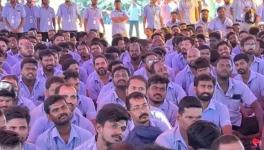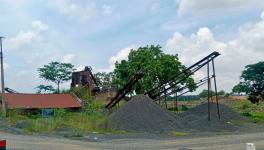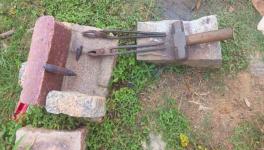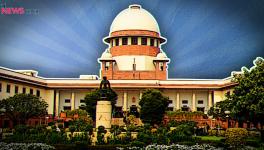TN: Madurai Villagers Save Their Hills, Pools and Livelihood from Granite Quarries
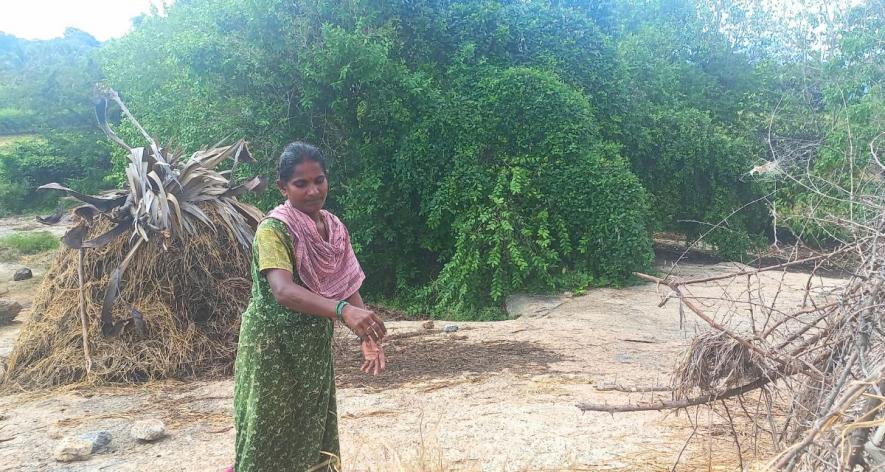
Madurai: “Many villagers suffered from kidney ailments as the pools and borewells became highly contaminated. After the granite quarries shut, such deaths gradually decreased. However, agriculture was still almost impossible, which forced many to leave that village.”
The searing pain of losses — of livelihood and loved one — is still evident in the words of D Indira (40), whose husband, P Durairaj, died of a kidney ailment a decade ago. Afterwards, she left her marital home at Saruguvalayapatti with her two school-going sons to live with her niece, A Pushpavalli, at Ottakovilpatti, located 15 km away.
Everything went well until Madurai Collector MS Sangeetha issued a notification on October 3 2023, inviting tender applications for extracting multi-coloured granites from four locations in Sekkipatti, Ayyapatti and Thiruchunai revenue villages in Melur taluk for a 20-year lease.
The notification sent shock waves across these villages as they already have examples of the devastation caused by illegal mining in the taluk before them. Protests were launched by people in not only the affected villages but also from about 10 surrounding villages, including Kambur and Ottakovilpatti.
Pushpavalli (32), one of the lead protest organisers, and her family sustain a landholding measuring a little over two acres. “My chitthi [maternal aunt] was married off at 16 and widowed at 30. We could cultivate because there is no granite mining here. Almost all the rocks drain rainwater into adjacent tanks. Destroying this natural irrigation system means destroying our lives,” she said.
Diversity rules here
Arittapatti Biodiversity Heritage Site is spread across Arittapatti in Melur taluk and Meenakshipuram in Madurai East taluk. Arittapatti boasts of a rock-cut Shiva temple housing one of the state's only two sculptures of Laguleesa, besides sculptures of Jain Tirthankaras with 2,200-year-old Tamil Brahmi scripts etched below them.
Arittapatti could not have attained its special status if a similar protest had not taken place in 2011, which forced the state government to go back on its order, allowing a granite quarry in the same hillets that the government is keen on protecting now. The site has about 100 mountain pools and shelters about 170 species of birds and animals such as endangered slender loris.
Though the villages that mounted protests recently are not officially a part of this site, their significance is no less. During a field visit, 101Reporters observed that a majority of the hillets have centuries-old Jain beds.
Ayyampatti, Sekkipatti and Kambur panchayats had passed grama sabha resolutions against granite quarries. Notably, Ayyampatti village council had initially passed a resolution to establish a granite quarry “for employment opportunities”, but it had to adopt an exactly opposite resolution at the grama sabha due to public outrage.
The district administration did not conduct any public hearings of the villagers. District Collector Sangeetha stated at the farmers’ grievance meeting in October that public hearings are mandatory only when the proposed quarry area is above five acres.
The quarries are supposed to maintain a safety distance of 50 m from reservoirs, canals, civil structures and habitations. However encroachment of waterbodies by the quarries was rampant in the past. There is no specific safety distance mentioned with respect to agricultural lands; however, it is 7.5 m for patta land and 10 m for government poramboke land. Since various classifications of agricultural lands are also part of patta lands, the minimum distance explicitly prescribed for farmlands is just 7.5 m.
Following repeated representations and relentless protests, the auction was postponed. Later, the Collector cancelled it, citing “administrative reasons”. However, fear looms large as the tender notification issued as a government order (GO) was withdrawn only through a press release dated November 29, 2023, making it legal for the district administration to invite the tender again. Following the 2011 protests, the GO that enabled the quarry auction itself was withdrawn, unlike the present situation. A few expressed suspicions that a similar tender may be called again after the Lok Sabha elections.
A perceived opportunity that turned fatal
“When the quarries started operating 20 to 30 years ago, the villagers saw it as an employment opportunity. On realising the damage, they began to oppose mining. Because of the serious irregularities in the past, there are no active granite mines in the district. So the government wants them back,” said A Selvaraj (43), a Kambur native and protest organiser.
The district administration made Selvaraj sign a ‘security for good behaviour’ under Section 110 of the CrPC, which is usually charged against habitual offenders. He had to approach the Madurai Bench of the Madras High Court (HC) to get the bond quashed. “Because of the pressure and negative publicity, the administration may not come back to these three panchayats, but other villages in Melur have to be cautious,” he said.
Melur Revenue Divisional Officer S Jayanthi told 101Reporters that no new tender notification would be issued for the villages where it has been withdrawn recently.
Notwithstanding, the Union Ministry of Mines conducted a preliminary study for establishing tungsten mines in the Melur region recently. “This is a Union Government project. The state government has not been involved till this stage,” P Balakrishnan, Deputy Director, Department of Geology and Mining, Madurai district, told 101Reporters.
To understand why the area may be subjected to further mining, one has to revisit its dark past. “I do not want to talk about my past,” a goat herder was emphatic when asked about illegal quarries. After much persuasion, she said, “The 1.5-acre agricultural land was our only source of income. After quarries came up, the land became barren all of a sudden.”
“One evening, pieces of rock fell on my house after a blast. My daughter, then aged 9, was saved by a distance of a foot or two. I went to the quarry and shouted at them. That very night, the goons of the quarry owner attacked my husband. Huge granite blocks were kept in our land to block access. We were forced to sell it for a pittance they offered,” she lamented.
The situation is dire in Adanjan Kanmaipatti, which is housing about 100 families. The village is named after Adanjan Kanmai, a pool that no longer exists. There were 12 pools, but none at present. “All these lands were once pools and farmlands,” said native P Karuppaiya, who had stopped farming to work in a quarry. He now rears two cows to make a living.
Explaining environmental impacts
“Quarrying can lead to land degradation. Fine dust spreads through the air and [potentially] destroys the natural surface vegetation,” said C Kavin Kumar, a doctorate holder in geotechnical engineering working as a soil investigation expert in Saudi Arabia.
“Quarries can lower groundwater and surface water levels because of mining operations and dewatering [artificially removing water during mining, tunnelling, etc.]. The groundwater conduit paths will be affected as rocks are removed,” he said, adding that the leaching effect and transport of chemicals through the air might have contaminated the soil.
Even when the quarry is filled with water, the village pool, barely 50 m away, is in dearth of water. Lying closer to Adanjan Kanmaipatti's end of the quarry, this is the only dry pool that 101Reporters saw among the 30-plus pools in over 15 villages. Farmlands in the villages adjacent to erstwhile quarries looked parched.
Explaining the science behind it, Kumar said water from a nearby groundwater source might have drained towards the quarry as water will flow in the higher gradient direction. A higher gradient direction indicates the direction of the steep slope. In simple terms, the water inundated the quarry as its surface level is much lower than that of the pool.
Pandora’s box
Melur was little known outside before May 2012, when the then Madurai collector, U Sagayam, wrote to the state government alleging that major violations in granite mining had caused huge environmental damages and a loss of about Rs 16,000 crore to the state exchequer.
Sagayam was moved out of Madurai after the explosive report but later appointed as Legal Commissioner by the Madras HC to inquire into the illegalities following a Public Interest Litigation in 2014. Many serious allegations came up against granite firms, including that of human sacrifice by the former driver of PRP Exports owner PR Palanisamy. Palanisamy and many others were convicted for illegal mining in the following years. However, the majority of the cases are still under trial.
Sagayam submitted his report to the government through the Madras HC in 2015. The government told the court in 2018 that it has accepted a certain number of recommendations. However, the report has not yet been made public. Though the power shifted from AIADMK to DMK in 2021, the government's stance has not changed.
“In the report, I stated a loss of Rs 1,11,000 crore, of which Rs 70,000 crore was the value of the granite mined illegally, and the remaining the government was legally bound to collect as a penalty from violators,” said Sagayam, who took voluntary retirement from the Civil Services in 2021.
“Apart from deforestation, the agrarian economy and rural infrastructure were devastated. Tanks, lakes and channels that were part of the irrigation system were destroyed. The Geological Survey of India has ascertained the age of these hills as 200 to 250 crore years. Some of them have 2,200-year-old Tamil Brahmi scriptures and Jain beds,” said Sagayam, who even spent a night at a graveyard in E Malampatti village to prevent the destruction of evidence when allegations of human sacrifice came up.
“My recommendations can be categorised into three — punishment for the guilty, monetary recovery in lieu of the resources exploited and ways to prevent such violations in future,” said Sagayam. However, the government has not yet communicated to him about the actions taken based on his report.
(Vignesh A is a Tamil Nadu-based freelance journalist and a member of 101Reporters, a p
Get the latest reports & analysis with people's perspective on Protests, movements & deep analytical videos, discussions of the current affairs in your Telegram app. Subscribe to NewsClick's Telegram channel & get Real-Time updates on stories, as they get published on our website.









